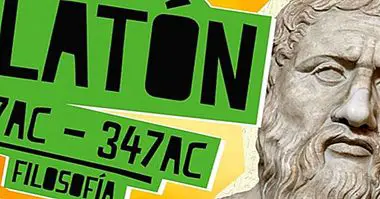The 8 theories of altruism: why do we help others for nothing?
Giving to others, helping the other without expecting anything in return. Although today it is not so usual since we are immersed in an increasingly individualistic culture , it is still possible to observe from time to time the existence of a large number of acts of spontaneous generosity and disinterested help to the other. And not only the human being: altruistic acts have been observed in a large number of animals of species as different as chimpanzees, dogs, dolphins or bats.
The reason for this type of attitude has been the subject of debate and research from sciences such as psychology, ethology or biology, generating a large number of theories about altruism . It is about them that will be discussed throughout this article, highlighting some of the best known.
- Related article: "Altruism: development of the prosocial self in children"
Altruism: basic definition
We understand altruism as that pattern of behavior or behavior characterized by the search for the welfare of others without expecting that it will generate any kind of benefit , despite the fact that such action may even harm us. The welfare of others is therefore the element that motivates and guides the behavior of the subject, we are talking about a punctual act or something stable in time.
The altruistic acts are generally well seen socially and allow generate well-being in others, something that affects the bond between individuals in a positive way. However, at a biological level altruism is an action that in principle it is not directly beneficial for survival and even that it can end up putting it at risk or causing death, something that has made the different researchers think about the emergence of this type of behavior.
- You may be interested: "The theory of moral development of Lawrence Kohlberg"
Theories about altruism: two great points of view
Why a living being may be willing to sacrifice his life, cause him harm or simply use his own resources and efforts in one or several actions that they do not make any profit has been the object of great research from different disciplines, generating a great number of theories. Among all of them, we can highlight two large groups in which theories about altruism can be inserted
Pseudo-altruistic theories
This type of theories about altruism is one of the most important and has had greater consideration throughout history. They are called pseudo-altruists because what they propose is that fundamentally the altruistic acts do pursue some kind of own benefit, even at the unconscious level .
This search would not be a direct and tangible benefit for the performance, but the motivation behind the altruistic act would be to obtain internal rewards such as self-approval, the feeling of doing something considered good by another or the monitoring of one's moral code. As well the expectation of future favors would be included on the part of the beings to whom we provide help.
Purely altruistic theories
This second group of theories considers that altruistic behavior is not due to the intention (conscious or not) of obtaining benefits, but rather that part of the direct intention of generating well-being to the other . It would be elements such as empathy or the search for justice that would motivate the performance. This type of theories usually take into account the relatively utopian that is to find a total altruism, but they value the existence of personality features tending to them.
Some of the main explanatory proposals
The two previous ones are the two main existent approaches regarding the functioning of the altruism, but within both a great amount of theories are included. Among them, some of the most notable are the following.
1. Reciprocal altruism
Theory that from the pseudoaltruism approach advocates that what really moves the altruistic behavior is the expectation that the help provided will subsequently generate an equivalent behavior in the person helped, in such a way that in the long run the chances of survival are enhanced in situations where the resources themselves may not be enough.
Also, who receives the aid benefits from this at the same time tend to feel indebted to the other . It also enhances and favors the possibility of interaction between both individuals, something that favors the socialization between unrelated subjects. He has the feeling of being in debt.
2. Normative theory
This theory is very similar to the previous one, with the exception that it considers that what moves the person who helps is the moral / ethical code or values, its structuring and the feeling of obligation towards others derived from them. It is also considered a theory of the approach of pseudoaltruism, since what is sought with the help of the other is to obey the social norm and the expectations of a world together that have been acquired during socioculturally, avoiding the fault of not helping and obtaining the gratification to have done what we consider correct (thus increasing our self-consideration).
3. Theory of stress reduction
Also part of the pseudo-altruistic approach, this theory considers that the motive of helping the other is the reduction of the state of discomfort and agitation generated by the observation of another person's suffering. The absence of action would generate guilt and increase the discomfort of the subject, while help will reduce the discomfort felt by the altruistic subject itself by reducing the other.
4. The selection of the kinship of Hamilton
Another of the existing theories is that of Hamilton, who considers that altruism is generated by the search for the perpetuation of genes. This theory of eminently biological load values that in nature many of the altruistic behaviors are directed towards members of our own family or with whom we have some kind of consanguineous relationship .
The act of altruism would allow our genes to survive and reproduce, even though our own survival could be impaired. It has been observed that a large part of altruistic behaviors is generated in different animal species.
5. Costs-benefits calculation model
This model considers the existence of a calculation between costs and benefits of both acting and not acting when performing an altruistic act, specifying the existence of fewer risks than possible benefits to be obtained. The observation of the suffering of others will generate tension in the observer, something that will lead to the activation of the calculation process. The final decision will also be influenced by other factors, such as the degree of linkage with the subject that needs help.
6. Autonomous altruism
A model more typical of the purely altruistic approach, this proposal assumes that emotions are what generate the altruistic act: the emotion towards the subject in distress or towards the situation generates that the basic principles of reinforcement and punishment cease to be taken into account. This model, worked among others by Karylowski, takes into account that for altruism to be really such it is necessary that the attention is focused on the other (If it were focused on oneself and the sensations it causes, we would be faced with the product of normative theory: an altruism by the fact of feeling good about oneself).
7. Hypothesis of empathy-altruism
This hypothesis, by Bateson, also considers altruism as something pure and not biased by the intention to obtain any kind of reward. The existence of several factors to be taken into account is assumed, being the first step to be able to perceive the need for help from others, the differentiation between their present situation and that which would imply their well-being, the salience of this need and the focus on the other . This will generate the appearance of empathy, putting ourselves in the place of the other and experiencing emotions towards him.
This will motivate us to seek their welfare, calculating the best way to help the other person (something that could include leaving the help to others). Although aid can generate some kind of social or interpersonal reward but that it is not the objective of the aid itself .
8. Empathy and identification with the other
Another hypothesis that considers altruism as something pure proposes the fact that what generates altruistic behavior is the identification with the other, in a context in which the other is perceived as needing help and through identification with him we forget the limits between the self and the person in need . This will end up generating that we seek their welfare, in the same way we would look for ours.
Bibliographic references:
- Batson, CD. (1991). The altruism question: Toward a socio-psychological answer. Hillsdale, NJ, England: Lawrence Erlbaum Associates, Inc .; England
- Feigin, S .; Owens, G. and Goodyear-Smith, F. (2014). Theories of human altruism: a systematic review. Annals of Neuroscience and Psychology, 1 (1). Available at: //www.vipoa.org/journals/pdf/2306389068.pdf.
- Herbert, M. (1992). Psychology in Social Work. Madrid: Pyramid.
- Karylowski, J. (1982). Two types of altruistic behavior: Doing good to feel good or to make the other feel good. In: Derlega VJ, Grzelak J, editors. Cooperation and helping behavior: theories and research. New York: Academic Press, 397-413.
- Kohlberg, L. (1984). Essays on moral development. The psychology of moral development. San Francisco: Harper and Row, 2
- Trivers, R.L. (1971). The evolution of reciprocal altruism. Quarterly Review of Biology 46: 35-57.



















